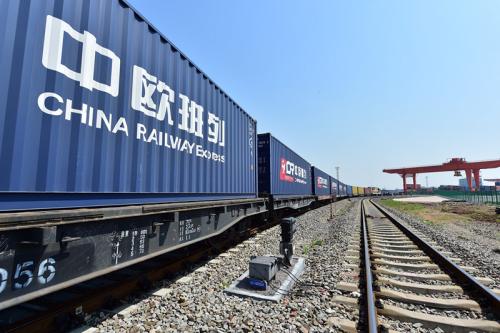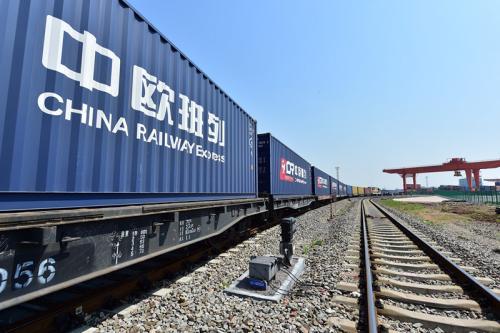
BEIJING, Jan. 15 (Xinhua) -- With the rapid development of trade and economic exchanges between China and Europe , the number of China-Europe freight trains in operation surges rapidly in 2017, according to a report released by the 21st Century Business Herald.
By the end of 2017, the China-Europe freight trains had already run for six years.
According to official statistics, the accumulated number of China-Europe freight trains had amounted to 6,235 in the past six years. In 2017, the amount hit 3,271, exceeding the total of the previous five years, while 57 train lines were arranged operating in 35 cities in China, smoothly connecting 34 cities in 12 European countries. Therefore, 2017 is seen as the “speed-up year” of China-Europe freight trains.
Chinese authorities shall further pare down subsidies on China-Europe freight trains and improve the degree of market operation, said analysts, adding that the significance of China-Europe trains shall not be simply measured by the current profitability and the number of trains running, but more importantly by the contribution to driving local economic development and opening-up.
Summing up the operational data of China-Europe freight trains in 2017, the analyst also discovered the following highlights.
Firstly, the running frequency increases, which indicate more and more cargo owners start to choose and accept railway transportation.
Secondly, the amount of trains shot up. In 2017, there were altogether 375 Wuhan-European trains shuttling back and forth between Wuhan and Europe, a growth of 25 percent over the amount of 300 planned at the beginning of the year, and an increase of about 70 percent over 2016’s total of 222. The number of China-Europe trains in operation exploded in 2017, representing an achievement of long-term market cultivation by all local governments and train operating companies.
Thirdly, the number of cities operating China-Europe trains rose. In 2017, there were up to 57 China-Europe train lines running in 35 cities in China, linking 34 cities in 12 European countries. The increase of train routes and cities is mainly due to the accelerated railway construction and increased density of railway network in recent two years in China.
Fourthly, there were more varieties of freight. The type of cargo has steadily expanded from IT products such as mobile phones and computers at the initial stage of the operation to more varieties such as clothing, shoes and hats, automobile and spare parts, grain, wine, coffee beans, timber, furniture, chemicals and mechanical equipment.
However, 2018 will still see challenges in many aspects that shall be jointly solved by the operators of China-Europe freight trains, local governments and their leadership in each area.
Firstly, how to further increase homebound cargo while shipping more goods to Europe is an issue each China-Europe freight train needs to solve continuously. Based on statistics, automobile, electronics and related spare parts are the main outbound products of China-Europe freight trains in all the cities. These products, in addition to their high added value, also reflect to some extent that high-tech industries are currently the hot directions of economic and trade cooperation between China and Europe.
Secondly, so far government subsidies remain as the key contribution to maintaining the operation of most China-Europe freight trains. Though government subsidies could help China-Europe freight trains get over operating difficulties at the beginning stage, cutting such subsidies and enhancing market operation degree will be a future trend for China-Europe freight trains. On October 17, 2017, the Department of Commerce of Guangdong Province publicized its subsidy fund plan for China-Europe freight trains in 2017, showing the total planned amount of subsidies was 87.2 million yuan in Guangdong province in the year. In accordance with the data announced by the province that three trains were run per week, the expected number of trains running would be 144 in 2017, which indicates the cost of subsidies is about 600,000 yuan per train.
The opening of China-Europe freight trains is subject to two conditions. One is the accessibility of local railways, while the other is the export-oriented level of local industry. Areas meeting the above two are qualified for the normal operation of China-Europe freight trains. As China builds up its railway network, more cities are attempting to widen trade with Europe through railway transportation.
The importance of the running of China-Europe freight trains cannot be simply weighed by existing profitability. What counts more is that it has spurred the development of local economy and opening-up.
Among the 35 cities running China-Europe freight trains now, more than half are inland areas. Thanks to China-Europe freight trains, these areas started to develop or undertake export-oriented industries, injecting impetus into the transformation and upgrading of local economic structure.
Analysts believed that at present the direct economic benefits generated by China-Europe freight trains might not be substantial; however we should need to focus on the role the China-Europe freight trains play, which is not only a “transportation corridor”, but also has profound influence on the economic development of a region.
Noting China-Europe freight trains’ role in leading local economy, we should all be clearly aware of the changes taking place in the development trend of China-Europe freight trains. In the new stage, the simple pursuit of the number of running trains in the past has gradually become outdated, and China-Europe freight trains will steer toward “high quality development”, analysts noted.
At the end of 2017, China-Europe Freight Train Transport Coordination Committee put forward that one of the priorities in 2018 is to accelerate the development of China-Europe trains with better quality. The performance review of China-Europe freight trains by administrative authorities shall no longer be based on the amount of trains in operation, but on the key performance data reflecting the actual operation of a certain train such as cargo load factor and cargo value.
(Edited by Yang Yifan, yangyifan@xinhua.org)




 A single purchase
A single purchase









